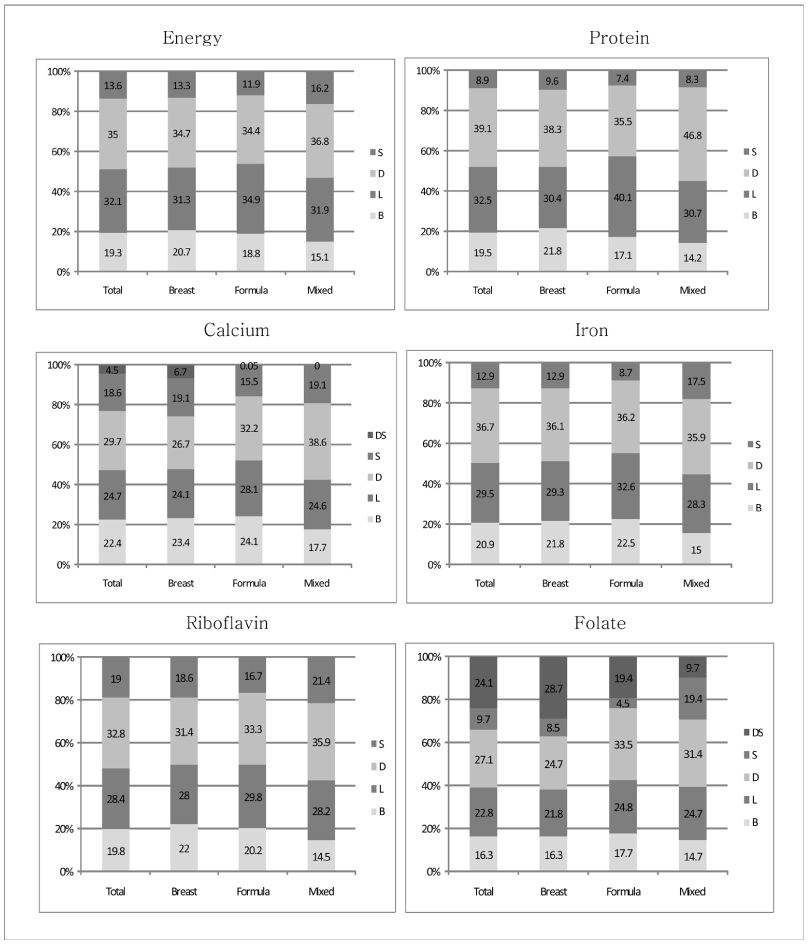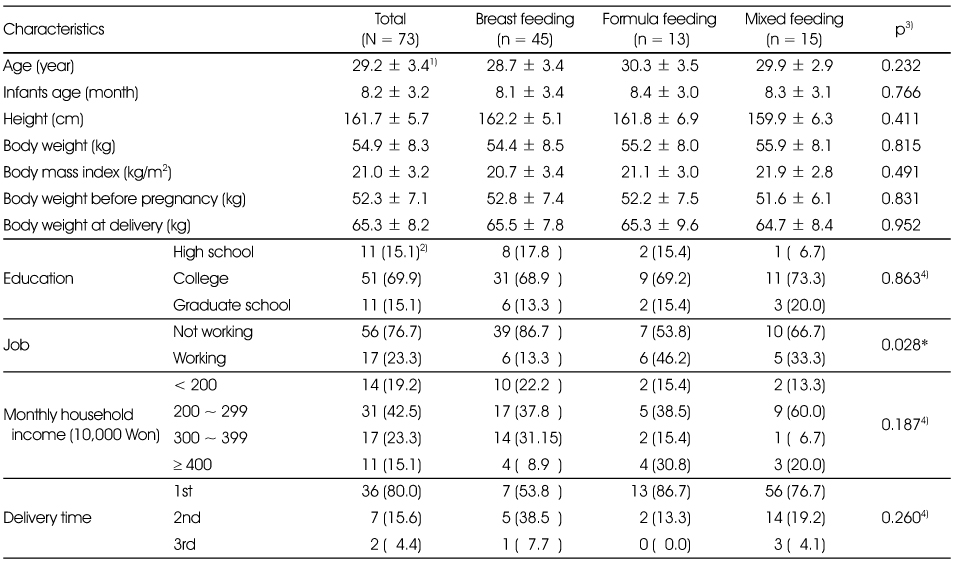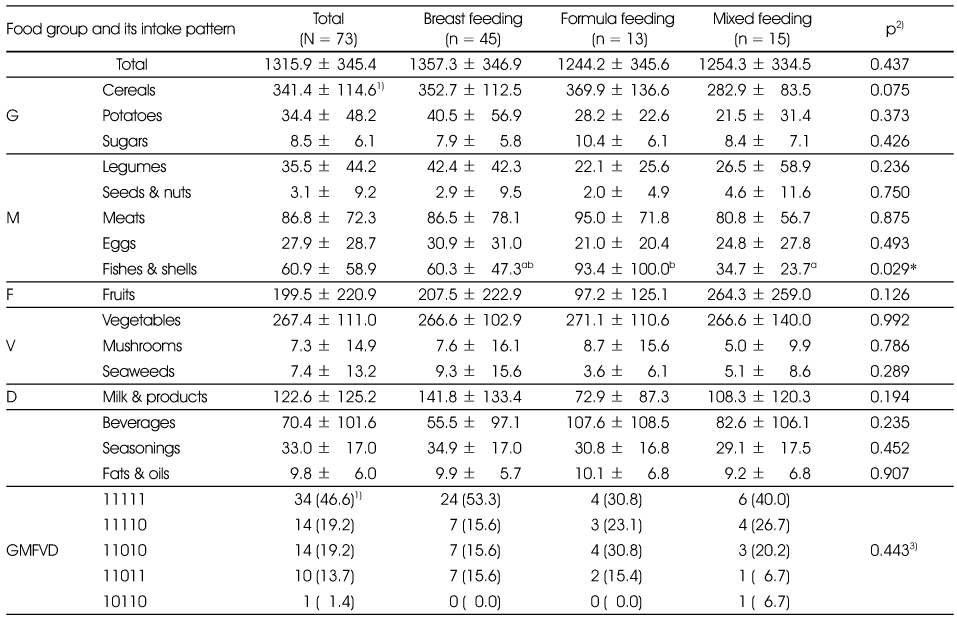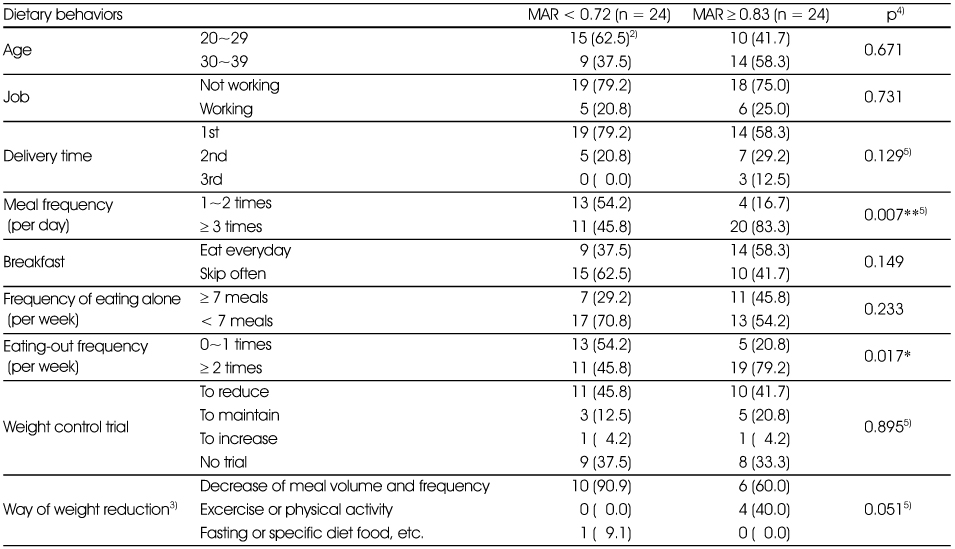Articles
- Page Path
- HOME > Korean J Community Nutr > Volume 16(1); 2011 > Article
-
Original Article
- Nutritional Status and Eating Behavior of Lactating Women in Daejeon
- Jisun Kim, Myung Soon Park, Joung-Won Lee
-
Korean Journal of Community Nutrition 2011;16(1):37-50.
DOI: https://doi.org/10.5720/kjcn.2011.16.1.37
Published online: February 28, 2011
Departments of Consumers' Life Information, Chungnam National University, Daejeon, Korea.
1Department of Food and Nutrition, Chungnam National University, Daejeon, Korea.
- Corresponding author: Joung-Won Lee, Departments of Consumers' Life Information, Chungnam National University, 99 Dahak-ro, Yuseong-gu, Daejeon 305-764, Republic of Korea. Tel: (042) 821-6844, Fax: (042) 821-8887, leejw@cnu.ac.kr
Copyright © 2011 The Korean Society of Community Nutrition
- 1,053 Views
- 1 Download
- 4 Crossref
Abstract
- Nutrients intake status of 73 lactating women, that is 45 breast feeding (BF), 13 formula feeding (FF) and 15 mixed feeding (MF), living in Daejeon was investigated. Self-recorded food intakes for two weekdays and eating behaviors using questionnaires were surveyed from May to August 2008. Subjects aged 29.2 ± 3.4 years and their infants aged 8.2 ± 3.2 months. Body mass index of the subjects was 21.0 ± 3.2. Of the subjects 23.3% were employed. Daily energy intake was 1953 ± 391 kcal. Mean adequacy ratio (MAR) was 0.77 ± 0.14 and was higher in FF (0.86 ± 0.13) than in BF (0.76 ± 0.11) and MF (0.72 ± 0.18). Nutrients that over 50% of the subjects took less than estimated average requirement were vitamin A, riboflavin, folate, vitamin C and calcium. And index of nutritional qualities of those 5 nutrients were below one Forty six and sixths percent (46.6%) of the subjects showed GMFVD = 11111 pattern of five food group intakes and 57.5% took meals three times daily, 56.2% skipped often breakfast, and 64.4% dined out two times and more per week. Subjects having lower MAR (< 0.72, n = 24), compared with those having higher MAR (≥ 0.83, n = 24), showed more skipping daily meals and less frequency of eating-out, and took less legumes, vegetables, fishes, and milk. As the results, intakes of calcium, vitamin A, riboflavin, folate, and vitamin C were insufficient in lactating women, especially in BF and MF mothers. Meal skipping and low intakes of dairy foods, legumes, vegetables, and fishes might have adverse influences on nutritional status of lactating women. Accordingly, nutrition care program for lactating women should be focused on intake of three meals daily and a variety of food.
- 1. Ahn BRM. Comparison among the interest of weight control, health related factors and dietary habits according to the obese index in female college students. 2005; Wonkwang University; MS thesis.
- 2. Ahn HS. Nutritional intake levels of Korean infants. Korean J Community Nutr. 1999; 4(4): 610-622.
- 3. Ahn HS, Bai HS, Kim SY. Research on biological and sociobehavioral factors affecting determinants of breast feeding duration. Korean J Nutr. 1995; 28(4): 331-344.
- 4. Butte NF, Garza C, Stuff JE, O'Brian SE, Nichols BL. Effects of maternal diet and body composition on lactational performance. Am J Clin Nutr. 1984; 39: 296-306.PubMed
- 5. Chang NS, Kang MH, Paik HY, Kim IH, Choi YW, Park SC, Shin YW. Serum folate and iron levels of pregnant, lactating, and non-pregnant, non-lactating women. Korean J Nutr. 1993; 26(1): 67-75.
- 6. Choi KS, Lee HJ. A study on knowledges and attitudes about breast milk feeding and needs for breast milk feeding education among high school students. Korean J Community Nutr. 2006; 11(2): 191-204.
- 7. Choi MH, Moon SJ, Ahn HS. An ecological study of changes in components of human milk during the breast feeding and the relationships between the dietary behavior of lactating women and the growth of breast-fed Infants. Korean J Nutr. 1991; 24(2): 77-86.
- 8. Choi MG, Ahn HS. Influence of matemal diet on mineral and trace element contents of human milk and relationships between level of these milk constituents. Korean J Nutr. 1993; 26(6): 772-782.
- 9. Hwang HS, Lee JS. A study of teacher's breakfast behavior and ideal breakfast types. Korean J Community Nutr. 1999; 4(4): 575-586.
- 10. Hyun WJ, Song KH, Choi MK, Son SM. Food energy and nutrient composition table easy to understand. 2007; Seoul: Kyomunsa.
- 11. Jeon HS, Hong SY. A study of factors affecting status and method of infant feeding in Incheon. Korean J Community Nutr. 1996; 1(3): 433-440.
- 12. Kant AK, Schatzkin A, Ziegler RG, Nestle M. Dietary diversity in the US population NHANES II. 1976~1980. J Am Diet Assoc. 1991; 91: 1526-1531.ArticlePubMed
- 13. Kim WJ, Ahn HS, Chung EJ. Mineral intakes and serum mineral concentrations of the pregnant and lactating women. Korean J Community Nutr. 2005; 10(1): 59-69.
- 14. Kim KN, Hyun TS, Kang NM. A survey on the feeding practices of women for the development of a breast-feeding education program: Breast feeding knowledge and breast feeding rates. Korean J Community Nutr. 2002; 7(3): 345-353.
- 15. Koo JY, Lee JW, Choi YS, Kim JH, Lee JH. Nutrition throughout the life cycle. 2006; Seoul: Hyoil Co..
- 16. Korea Dietetic Association. Food weights by eye measurement and food pictures. 1999.
- 17. Korean Society of Community Nutrition. Questionnaires for surveying dietary life. 2000.
- 18. Lee JS, Choi KS, Kim ES. Changes on milk production of lactating women in Kwangwon province during lactation. Korean J Nutr. 1996; 29(10): 1105-1111.
- 19. Lee GJ, Moon SJ, Lee MJ, Ahn HS. Postpartum changes in maternal diet, body fat and anthropometric measurements in lactating vs non-lactating women. Korean J Nutr. 1993; 26(1): 76-88.
- 20. Lee JA, Huh YR, Lee JI, Lim HS. Composition and yield of Korean breast milk and maternal intakes of foods and nutrients. Korean J Nutr. 1994; 27(8): 795-804.
- 21. Lee JW, Lee MS, Kim JH, Son SM, Lee BS. Nutritional assessment. 2006; Seoul: Kyomunsa.
- 22. Lee SI, Choi HM. Nutrition for infants and children. 2002; Seoul: Kyomunsa.
- 23. Lee YK, Sung CJ, Choi MK, Lee YS. Effects of sodium intakes on blood pressure and blood parameters in Korean normal adult women. Korean J Nutr. 2002; 35(7): 754-762.
- 24. Feeley RM, Eitenmiller RR, Jones JB, Barnhart H. Calcium phosphorus and magnesium contents of human milk during early lactation. J Pediatr Gastroenterol Nutr. 1983; 2: 262-267.ArticlePubMed
- 25. Ministry of Health and Welfare, Korea Health Industry Development Institute. Report on 2005 National Health and Nutrition Survey : Nutrition Survey(1). 2006.
- 26. Moon SJ, Kang JS, Lee MJ, Lee JH, Ahn HS. A longitudinal study of macro-mineral concentrations in human milk. Korean J Nutr. 1993; 26(9): 1098-1109.
- 27. Moon HK, Kim EG. Nutrient and food intake of Koreans by the economic status and meal pattern using 1998 Korean national health examination nutrition survey. Korean J Nutr. 2004; 37(3): 236-250.
- 28. Nam KS. How to use SPSS for statistical analysis. 2007; Seoul: Chayou Academy.
- 29. Ngoan LT, Mizoue T, Fujino Y, Tokui N, Yoshimura T. Dietary factors and stomach cancer mortality. Br J Cancer. 2002; 87(1): 37-42.
- 30. Ro HK. Infant feeding practices in Kwangju area. J Korean Soc Food Nutr. 1994; 23(1): 48-54.
- 31. Rural Development Administration and Korean Society of Community Nutrition. Food composition tables easy to understand for consumers. 2003.
- 32. Takeda Y, Yoneda T, Demura M, Furukawa K. Effects of high sodium intake on cardiovascular aldosterone synthesis in stroke-prone spontaneously hypertensive rats. J Hypertens. 2001; 19(3): 635-639.PubMed
- 33. The Korean Nutrition Society. Dietary reference intakes for Koreans. 2005.
- 34. Wang SK, Kim JH. A study on infant feeding and weaning practice in Taejon. Korean J Community Nutr. 1999; 4(4): 489-495.
- 35. Worthington-Roberts BS, Williams SR. Nutrition in pregnancy and lactation. 1989; St Louis: CV Mosby Co..
- 36. Yoon JS, Chang HK, Park JA. A study on calcium and iron status of lactating women. Korean J Nutr. 2005; 38(6): 475-486.
REFERENCES




Figure & Data
REFERENCES
Citations

- A comparative study on nutritional knowledge and dietary behavior between Korean and Chinese postpartum women
Sohyun Kim, Heewon L Gray, Jia Li, Haeryun Park, Youngmi Lee, Kyunghee Song
Nutrition Research and Practice.2019; 13(6): 535. CrossRef - Nutrient Composition and Content of Vitamin and Mineral Supplements and Their Appropriateness for Pregnant and Lactating Women in Korea
Young-Hee Han, Jeong-Hyeon Seo, Gu-Rum Shin, Ju-Young Shin, Ye-Young Jo, Taisun Hyun
Korean Journal of Community Nutrition.2018; 23(4): 341. CrossRef - Development of Education Materials as a Card News Format for Nutrition Management of Pregnant and Lactating Women
Young-Hee Han, Jung Hyun Kim, Min Jun Lee, Taeksang Yoo, Taisun Hyun
Korean Journal of Community Nutrition.2017; 22(3): 248. CrossRef - The Association between Oxidative Stress and Metabolic Syndrome in Adults
So-Won Chung, Sung-Goo Kang, Jun-Seung Rho, Ha-Na Kim, In-Sun Song, Yun-Ah Lee, Soo-Jeong Heo, Sang-Wook Song
Korean Journal of Family Medicine.2013; 34(6): 420. CrossRef


Fig. 1
Fig. 2
General characteristics of the subjects
1) Mean ± SD, 2) N (%), 3) by ANOVA and χ2-test *: p < 0.05, 4) Subject number of one cell and more was below 5 in the variable
Energy, protein and lipid intakes by milk feeding type
1) Mean ± SD, 2) Mean, 3) EER %, 4) AI %, 5) by ANOVA, *: p < 0.05, **: p < 0.01, ***: p < 0.001
abc: Values with different superscripts were significantly different at p < 0.05 by LSD
P/M/S = poly unsaturated fatty acid / mono unsaturated fatty acid / saturated fatty acid
Mineral and vitamin intakes by milk feeding type
1) Mean ± SD, 2) Mean, 3) Goal value %, 4) AI %, 5) by ANOVA, *: p < 0.05 **: p < 0.01 ***: p < 0.001
ab: Values with different superscripts were significantly different at p < .05 by LSD
Proportion of the subjects took nutrients less than EAR and unacceptable macronutrient distribution ranges
1) N (%), 2) by χ2 test, 3) All variables except 'Vitamin C' had one cell or more with the subject number below 5.
4) Acceptable macronutrient distribution ranges (carbohydrate : protein : lipid = 55 ~ 70 : 7 ~ 20 : 15 ~ 25)
Index of nutritional quality(INQ) by milk feeding type
1) Mean ± SD, 2) by ANOVA, *: p < 0.05 **: p < 0.01 ***: p < 0.001
ab: Values with different superscripts were significantly different at p < 0.05 by LSD
Food intakes and food group intake pattern by milk feeding type
1) Mean ± SD, 2) by ANOVA, *: p < 0.05
ab: Values with different superscripts were significantly different at p < 0.05 by LSD
3) Subject number of 10 cells were below 5
GMFVD: grain, meat, fruit, vegetable, dairy product
Dietary behavior and weight reducing trial by feeding type
1) N (%), 2) χ2 test, 3) Among subjects who did weight control trial to reduce weight
4) Subject number of one cell or more was below 5 in the variable
Comparison of food group intakes and its patterns between the subjects with MAR < 0.72 and those with MAR ≥ 0.831)
1) MAR ≥ 0.83: 100th~68th percentile, MAR < 0.72: 33th~0th percentile, 2) Mean ± SD, 3) by t-test
GMFVD: grain, meat, fruit, vegetable, dairy product, *: p < 0.05, **: p < 0.01, ***: p < 0.001
4) Subject number of 5 cells were below 5
Comparison of dietary behaviors between the subjects with MAR < 0.72 and those with MAR ≥ 0.831)
1) MAR ≥ 0.83: 100th~68th percentile, MAR < 0.72: 33th~0th percentile
2) N (%), 3) Among subjects who did weight control trial to reduce weight
4) χ2 test, *: p < 0.05, **: p < 0.01, 5) Subject number of one cell or more was below 5 in the variable
1) Mean ± SD, 2) N (%), 3) by ANOVA and χ2-test *: p < 0.05, 4) Subject number of one cell and more was below 5 in the variable
1) Mean ± SD, 2) Mean, 3) EER %, 4) AI %, 5) by ANOVA, *: p < 0.05, **: p < 0.01, ***: p < 0.001 abc: Values with different superscripts were significantly different at p < 0.05 by LSD P/M/S = poly unsaturated fatty acid / mono unsaturated fatty acid / saturated fatty acid
1) Mean ± SD, 2) Mean, 3) Goal value %, 4) AI %, 5) by ANOVA, *: p < 0.05 **: p < 0.01 ***: p < 0.001 ab: Values with different superscripts were significantly different at p < .05 by LSD
1) N (%), 2) by χ2 test, 3) All variables except 'Vitamin C' had one cell or more with the subject number below 5. 4) Acceptable macronutrient distribution ranges (carbohydrate : protein : lipid = 55 ~ 70 : 7 ~ 20 : 15 ~ 25)
1) Mean ± SD, 2) by ANOVA, *: p < 0.05 **: p < 0.01 ***: p < 0.001 ab: Values with different superscripts were significantly different at p < 0.05 by LSD
1) Mean ± SD, 2) by ANOVA, *: p < 0.05 ab: Values with different superscripts were significantly different at p < 0.05 by LSD 3) Subject number of 10 cells were below 5 GMFVD: grain, meat, fruit, vegetable, dairy product
1) N (%), 2) χ2 test, 3) Among subjects who did weight control trial to reduce weight 4) Subject number of one cell or more was below 5 in the variable
1) MAR ≥ 0.83: 100th~68th percentile, MAR < 0.72: 33th~0th percentile, 2) Mean ± SD, 3) by t-test GMFVD: grain, meat, fruit, vegetable, dairy product, *: p < 0.05, **: p < 0.01, ***: p < 0.001 4) Subject number of 5 cells were below 5
1) MAR ≥ 0.83: 100th~68th percentile, MAR < 0.72: 33th~0th percentile 2) N (%), 3) Among subjects who did weight control trial to reduce weight 4) χ2 test, *: p < 0.05, **: p < 0.01, 5) Subject number of one cell or more was below 5 in the variable

 KSCN
KSCN







 Cite
Cite


